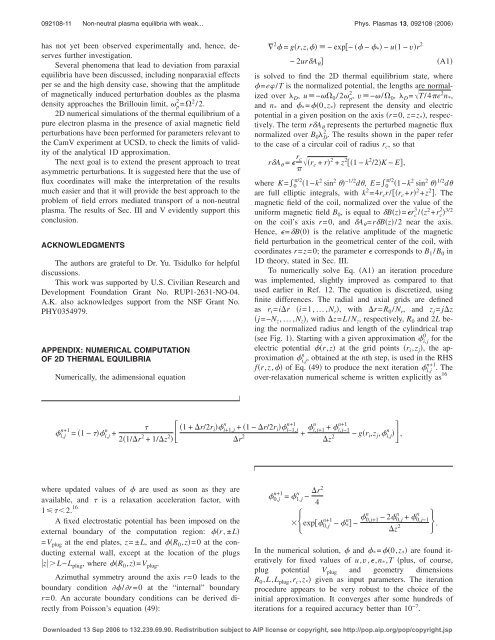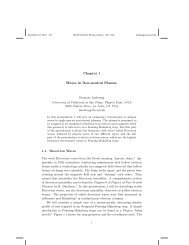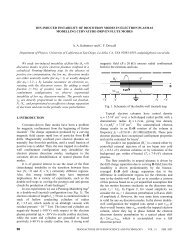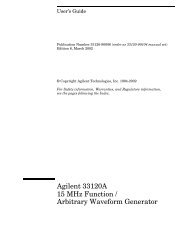Non-neutral plasma equilibria with weak axisymmetric magnetic ...
Non-neutral plasma equilibria with weak axisymmetric magnetic ...
Non-neutral plasma equilibria with weak axisymmetric magnetic ...
You also want an ePaper? Increase the reach of your titles
YUMPU automatically turns print PDFs into web optimized ePapers that Google loves.
092108-11 <strong>Non</strong>-<strong>neutral</strong> <strong>plasma</strong> <strong>equilibria</strong> <strong>with</strong> <strong>weak</strong>... Phys. Plasmas 13, 092108 2006<br />
has not yet been observed experimentally and, hence, deserves<br />
further investigation.<br />
Several phenomena that lead to deviation from paraxial<br />
<strong>equilibria</strong> have been discussed, including nonparaxial effects<br />
per se and the high density case, showing that the amplitude<br />
of <strong>magnetic</strong>ally induced perturbation doubles as the <strong>plasma</strong><br />
density approaches the Brillouin limit, p 2 = 2 /2.<br />
2D numerical simulations of the thermal equilibrium of a<br />
pure electron <strong>plasma</strong> in the presence of axial <strong>magnetic</strong> field<br />
perturbations have been performed for parameters relevant to<br />
the CamV experiment at UCSD, to check the limits of validity<br />
of the analytical 1D approximation.<br />
The next goal is to extend the present approach to treat<br />
asymmetric perturbations. It is suggested here that the use of<br />
flux coordinates will make the interpretation of the results<br />
much easier and that it will provide the best approach to the<br />
problem of field errors mediated transport of a non-<strong>neutral</strong><br />
<strong>plasma</strong>. The results of Sec. III and V evidently support this<br />
conclusion.<br />
ACKNOWLEDGMENTS<br />
The authors are grateful to Dr. Yu. Tsidulko for helpful<br />
discussions.<br />
This work was supported by U.S. Civilian Research and<br />
Development Foundation Grant No. RUP1-2631-NO-04.<br />
A.K. also acknowledges support from the NSF Grant No.<br />
PHY0354979.<br />
APPENDIX: NUMERICAL COMPUTATION<br />
OF 2D THERMAL EQUILIBRIA<br />
Numerically, the adimensional equation<br />
2 = gr,z,− exp− − * − u1−vr 2<br />
−2urA <br />
A1<br />
is solved to find the 2D thermal equilibrium state, where<br />
=e/T is the normalized potential, the lengths are normalized<br />
over D , u− 0 /2 p 2 , v−/ 0 , D = T/4e 2 n * ,<br />
and n * and * =0,z * represent the density and electric<br />
potential in a given position on the axis r=0, z=z * , respectively.<br />
The term rA represents the perturbed <strong>magnetic</strong> flux<br />
normalized over B 0 D 2 . The results shown in the paper refer<br />
to the case of a circular coil of radius r c , so that<br />
rA = r c<br />
r c + r 2 + z 2 1−k 2 /2K − E,<br />
<br />
where K= /2 0 1−k 2 sin 2 −1/2 d, E= /2 0 1−k 2 sin 2 1/2 d<br />
are full elliptic integrals, <strong>with</strong> k 2 =4r c r/r c +r 2 +z 2 . The<br />
<strong>magnetic</strong> field of the coil, normalized over the value of the<br />
uniform <strong>magnetic</strong> field B 0 , is equal to Bz=r 3 c /z 2 +r 2 c 3/2<br />
on the coil’s axis r=0, and A =rBz/2 near the axis.<br />
Hence, =B0 is the relative amplitude of the <strong>magnetic</strong><br />
field perturbation in the geometrical center of the coil, <strong>with</strong><br />
coordinates r=z=0; the parameter corresponds to B 1 /B 0 in<br />
1D theory, stated in Sec. III.<br />
To numerically solve Eq. A1 an iteration procedure<br />
was implemented, slightly improved as compared to that<br />
used earlier in Ref. 12. The equation is discretized, using<br />
finite differences. The radial and axial grids are defined<br />
as r i =ir i=1,...,N r , <strong>with</strong> r=R 0 /N r , and z j = jz<br />
j=−N z ,...,N z , <strong>with</strong> z=L/N z , respectively, R 0 and 2L being<br />
the normalized radius and length of the cylindrical trap<br />
see Fig. 1. Starting <strong>with</strong> a given approximation 0 i,j for the<br />
electric potential r,z at the grid points r i ,z j , the approximation<br />
n i,j , obtained at the nth step, is used in the RHS<br />
fr,z, of Eq. 49 to produce the next iteration n+1 i,j . The<br />
over-relaxation numerical scheme is written explicitly as 16<br />
n+1 i,j = 1− n i,j +<br />
<br />
21/r 2 +1/z 2 <br />
1+r/2r n<br />
i i+1,j<br />
n+1<br />
+ 1−r/2r i i−1,j<br />
r 2<br />
+ n n+1<br />
i,j+1 + i,j−1<br />
z 2 − gr i ,z j , n i,j ,<br />
where updated values of are used as soon as they are<br />
available, and is a relaxation acceleration factor, <strong>with</strong><br />
12. 16<br />
A fixed electrostatic potential has been imposed on the<br />
external boundary of the computation region: r,±L<br />
=V plug at the end plates, z=±L, and R 0 ,z=0 at the conducting<br />
external wall, except at the location of the plugs<br />
zL−L plug , where R 0 ,z=V plug .<br />
Azimuthal symmetry around the axis r=0 leads to the<br />
boundary condition /r=0 at the “internal” boundary<br />
r=0. An accurate boundary conditions can be derived directly<br />
from Poisson’s equation 49:<br />
n+1 = n<br />
1,j<br />
0,j<br />
− r2<br />
4<br />
exp 0,j<br />
n+1 − n * − n<br />
0,j+1<br />
−2 n n<br />
0,j + 0,j−1<br />
z 2 .<br />
In the numerical solution, and * =0,z * are found iteratively<br />
for fixed values of u,v,,n * ,T plus, of course,<br />
plug potential V plug and geometry dimensions<br />
R 0 ,L,L plug ,r c ,z * given as input parameters. The iteration<br />
procedure appears to be very robust to the choice of the<br />
initial approximation. It converges after some hundreds of<br />
iterations for a required accuracy better than 10 −7 .<br />
Downloaded 13 Sep 2006 to 132.239.69.90. Redistribution subject to AIP license or copyright, see http://pop.aip.org/pop/copyright.jsp








![WORKSHOP PARTICIPANTS LIST [pdf] - UC San Diego](https://img.yumpu.com/35298899/1/190x245/workshop-participants-list-pdf-uc-san-diego.jpg?quality=85)
